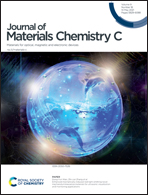The emergence and origin of broader light emission from two-dimensional layered (C12H25NH3)2MnCl4 at low-temperatures†
Abstract
We report a broadband light emission (∼350–800 nm) properties of two-dimensional layered (C12H25NH3)2MnCl4 inorganic–organic hybrid system in a large temperature range of ∼5–400 K. At room temperature, the emission spectrum weighs around the green while at temperatures lower than ∼200 K, the spectral weight shifts to longer wavelengths due to the emergence of a much stronger PL peak at ∼700 nm. This new feature originates from Mn4+ states, which become radiatively active at low temperatures. The same is substantiated through the calculation of the thermal activation energy in the configuration coordinate energy space for the energy decay through phonon channels. Moreover, the anomalous temperature dependence of the PL characteristics, above room temperature, is found to be correlated with multiple solid–solid phase transitions in this system. In comparison, similar experiments performed on Cu-based hybrids, namely (C12H25NH3)2CuCl4 and (C12H25NH3)2CuBr4, do not show any appreciable change in the PL spectrum including the wavelength corresponding to the PL-maximum, only the anomalous change in the PL-intensity around the solid–solid phase transition temperatures is observed. Our results suggest the presence of solid–solid phase transitions in these systems at temperatures much below room temperature.



 Please wait while we load your content...
Please wait while we load your content...